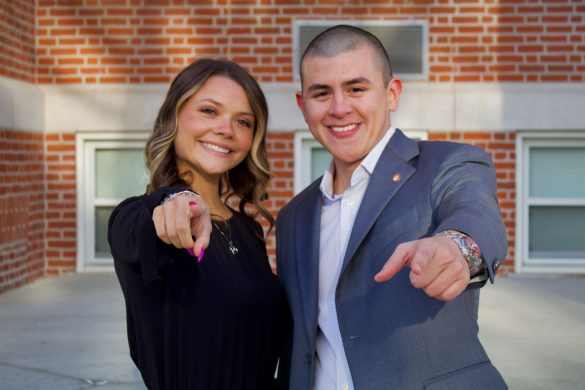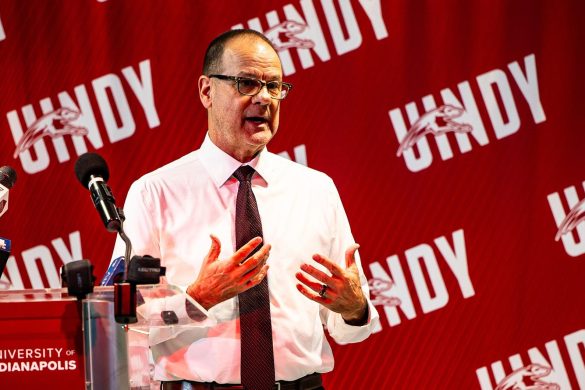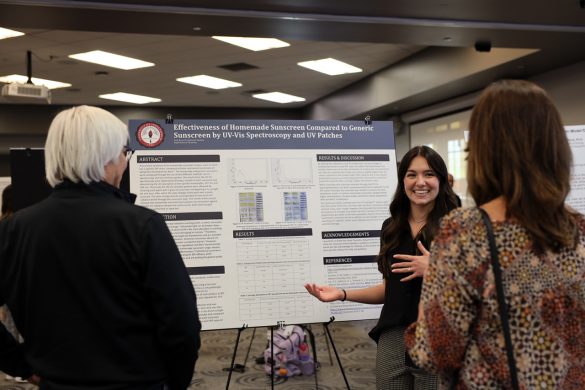Sugar skulls, marigolds, incense and candles: These are the staples of the Dia de los Muertos or “Day of the Dead” celebrations. Dia de los Muertos takes place on Nov. 1 and 2, which are also All Saints’ Day and All Souls’ Day, and originated in Mexico.
Professor of Spanish Ricardo Iman is from Mexico City, and he loves celebrating the holiday. According to Iman, Dia de los Muertos celebrations look different in different areas, but the point is to remember loved ones who have passed away and pay tribute to them. Iman said that in Mexico City, the celebrations take influence from Aztec culture and Catholicism, and the Aztec idea of souls going to different paradises depending on how one dies is a strong belief. For example, if a soldier dies, he or she will go to one paradise, while a woman who dies in childbirth will go to another, Iman said.
However, during Dia de los Muertos, the spirits of those who have passed away and gone to the different are believed to paradises return to the physical world of the living to visit loved ones. The first day of Dia de los Muertos is dedicated to remembering children who have passed away, while the second day is for adults.
“We put toys [and] candy for the children,” Iman said. “The next day … we put what they [the adults who passed away] used to like. If they used to drink some kind of tequila, we get the one they liked, whatever they liked. We put pictures, candles and incense just to call them in, like, ‘We’re here! Don’t get lost!’”
According to Iman, besides incense, candles and photos, marigolds also are used for Dia de los Muertos. He said that the marigolds’ color and smell is so intense that it is used to help guide spirits to the physical world. The flower is known as the flower of the dead, according to Iman.
Iman said that, before Nov. 1 and 2, celebrators pray for nine days for their loved ones who have passed. Altars are made with food offerings, flowers, incense, candles and photos. Offerings include food prepared for the spirits, and when the spirits come, they eat the “spirit of the food.” The living people then eat the physical food as part of the celebration. Candies, sugar skulls, sweetbreads and other items or offerings are made to the spirits, all of which are enjoyed by the living people, too.
Iman said that this is what a celebration looks like in Mexico City, but it may not in other parts of Mexico. For example, he said in Campeche, the tradition is to go to the cemetery, open the graves of the deceased and clean their bones. Celebrates then put the bones back once they are cleaned and rebury them. The point of this, Iman said, is to show that the living people still think and take care of the deceased and hopefully, in return, the spirits will take care of them, too.
Iman said that the belief that those who have passed are still with those who are alive helps those who celebrate the holiday cope and gain closure. Dia de los Muertos also reminds them that those who have died are not truly gone. According to Iman, because of the attitude surrounding Dia de los Muertos, he has noticed a difference between people who celebrate it and people who do not.
“I see a difference. I see less hope, less closure. With people who may be seeing misconceptions, I don’t see happiness in general,” he said.
Iman said that misconceptions about Dia de los Muertos usually come from people who do not understand the tradition and think that the subject is “creepy” or morbid. But Iman thinks that there is something scarier than spirits coming to the physical world.
“We believe there’s an afterlife,” Iman said. “I think it’s creepier not to believe that.”
While Dia de los Muertos is a Mexican holiday, there are ways to celebrate it in the United States. This past year, at the Eiteljorg Museum, there was a free Dia de los Muertos Community Celebration. According to the Eiteljorg Museum’s official website, attendees could watch performances, make art and shop at the marketplace. Attendees also could attend a Catrina parade, Catrina being a female skeleton who wears a large brimmed hat.
Nopal Cultural hosted the event. According to its official Facebook page, Nopal Cultural is “a multicultural arts organization that seeks to enhance Latino-American arts in Indianapolis” and was founded in 2012.
Altars were made and displayed at the Eiteljorg Museum. One altar was in remembrance of African Americans who were killed in police shootings and was made by UIndy graduate students Kalie Holdren and Ayla Wilder. Holdren was asked by one of Nopal Cultural’s founders, Eduardo Luna, if she would be interested in creating an altar. Holdren then reached out to Wilder about creating an altar. Wilder’s god family is Hispanic and from New Mexico. Growing up, she would celebrate Dia de los Muertos with them, so she was familiar with the holiday. Holdren and Wilder decided to create an altar inspired by the Black Lives Matter movement, but they wanted to go beyond the headlines.
“When Kalie and I talked about it, we felt like when you talk about different African Americans’ lives that are a part of the movement, who are the frontrunners of the movement, you get a lot about what happened that day, and that’s all you know about that person. You don’t really know about what their interests were, how their lives actually were, and so we wanted to shine them in a different light…. We decided that it would be a great outlet for people to get to know who those individuals were and not just the date they died.”
Holdren, who had celebrated Dia de los Muertos at the University of Notre Dame’s annual celebrations, decided that an altar in remembrance of African Americans who had died in police shootings would be a great way to reflect on the events.
“Day of the Dead is a time to celebrate the lives of those who are closest to us. I figured that creating an altar for those that we have lost in the Black Lives Matter movement would be a great way to reflect on everything that is happening and give a platform to those who have lost relatives as well,” Holdren said. “Ayla and I came up with the imagery that we wanted to use, as well as the people that we wanted to include in it.”
Wilder said that the altar included a scrapbook, with each page dedicated to the life of a person who had died. The pages included things like spoken word, poetry, their birthdays and other facts about their lives that Holdren and Wilder were able to find. Wilder said that they could not include everybody, but they did try to pick people that others might be familiar with and that others might not have been familiar with.
The back of the altar was dedicated to Emmett Till, who was lynched in Mississippi in 1955. He was 14 years old. Guests who stopped by the altar were able to leave notes to those who had passed and stick them to the altar.
“I didn’t want it to be a very sad thing, but I hope they [guests] understand that we want these individuals to be remembered by who they are as people,” Wilder said. “Their stories definitely need to be remembered because we don’t want history to repeat itself, but I want them to understand who those people were. They’re not just a news article. They were people who had lives and families who did daily chores like we do. And so I don’t want them to just be looked at like a bookmark in life, but like they were human beings.”
Wilder felt that creating the altar was a way of expressing her feelings to those that had passed.

In remembrance of African Americans killed by police shootings, two UIndy students created an altar. Photo contributed by Ayla Wilder
“[It] was just a way that I could personally express myself, saying how sorry I am, how really I do appreciate them even though their stories are tragic. … I do appreciate who they are and what they have done for our community, because although they passed, they haven’t been forgotten,” Wilder said. “And their stories and their lives have allowed a lot of people to see injustices that are present.”
Holdren also said that the altar had an effect on her personally as well.
“The part that impacted me the most was [the] interactive piece we added to our altar,” she said. “We left a stack of sticky notes for people to write on. Readings of the notes and seeing people’s messages really helped me realize that our decision to make our altar include Black Lives Matter was important. It helped create dialogue and help[ed] people relate it to their own lives and the people they have lost.”
Iman said that despite the name, the “Day of the Dead” is not just about death and the sadness that comes when someone beloved has passed. He said it is about remembering the love that goes beyond death, between friends and family, and that it is about celebrating and having fun in life, too.
“[My favorite thing about Dia de los Muertos is] the celebration of life. And love never ends,” Iman said. “So you don’t see sadness. You see hope…. They are there, and they are still taking care of you.”
Wilder said that Dia de los Muertos is a holiday for being thankful for those who have passed away and for the time that they were in a person’s life.
“It’s to celebrate their lives, their accomplishments, and to be happy for them,” she said, “[and] to be happy that their life experience was a part of yours.”










